Real Madrid travelled to Borussia-Park with a lot of confidence after winning the El Clásico. On the other hand, Borussia Mönchengladbach came from behind to earn a brilliant victory against FSV Mainz in the Bundesliga. Even though both the teams won their respective league games, both the teams are struggling to get their mojo back.
This UEFA Champions League fixture was of grave importance and a win for either team could have helped them to get back into their groove.
This tactical analysis will discuss the tactics of both the managers and the intricacies of the game. This analysis will also delve into the fact that Die Fohlen could have registered a win if Marco Rose tweaked his system a little in the dying minutes.
Line-ups
Marco Rose opted for a 4-4-2 formation as Die Fohlen did against Inter. Yann Sommer was protected by the backline of Remy Bensabaini, Nico Elvedi, Matthias Ginter, and Stefan Lainer. Florian Neuhaus and Christoph Kramer manned the midfield. Marcus Thuram and Jonas Hofmann positioned themselves on either side of Lars Stindl on the left and right flank respectively and the attack was spearheaded by the French Alassane Pléa.
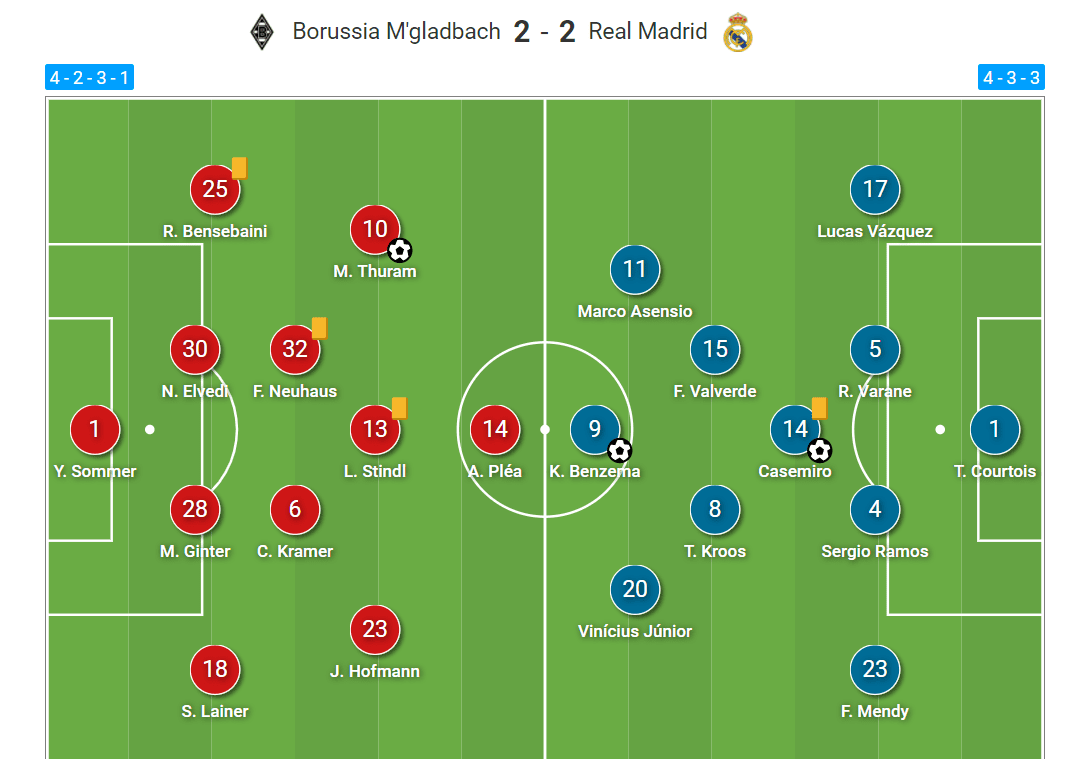
Zinedine Zidane started with his preferred 4-3-3 and almost the same starting XI as against Barcelona at the weekend. The only change was the makeshift Lucas Vázquez in place of Nacho Fernández in the right-back position.
Borussia Mönchengladbach could not take advantage of Real Madrid’s pressing structure
Real Madrid struggled enormously with their man-oriented pressing against Shakhtar Donetsk. Real Madrid pressed M’Gladbach high but opted out from their out and out man-marking, especially in the first few minutes. However, the away side did man-mark the M’Gladbach midfielders. Neuhaus and Kramer were mostly man-marked by Toni Kroos and Fede Valverde.

The above image depicts Real Madrid’s pressing structure in the early minutes. Kroos and Valverde man-marking the opposition midfielders. Karim Benzema man-marked Die Fohlen’s LCB, Elvedi, and had the responsibility of pressing the RCB, Ginter, keeping Elvedi in the cover shadow if the ball was passed to Ginter. The wingers, Asensio and Vinícius, positioned themselves in their respective half spaces and pressed their respective wingers. Mendy had the task of marking Hofmann (LW) who would often drop deep to open up passing lanes.
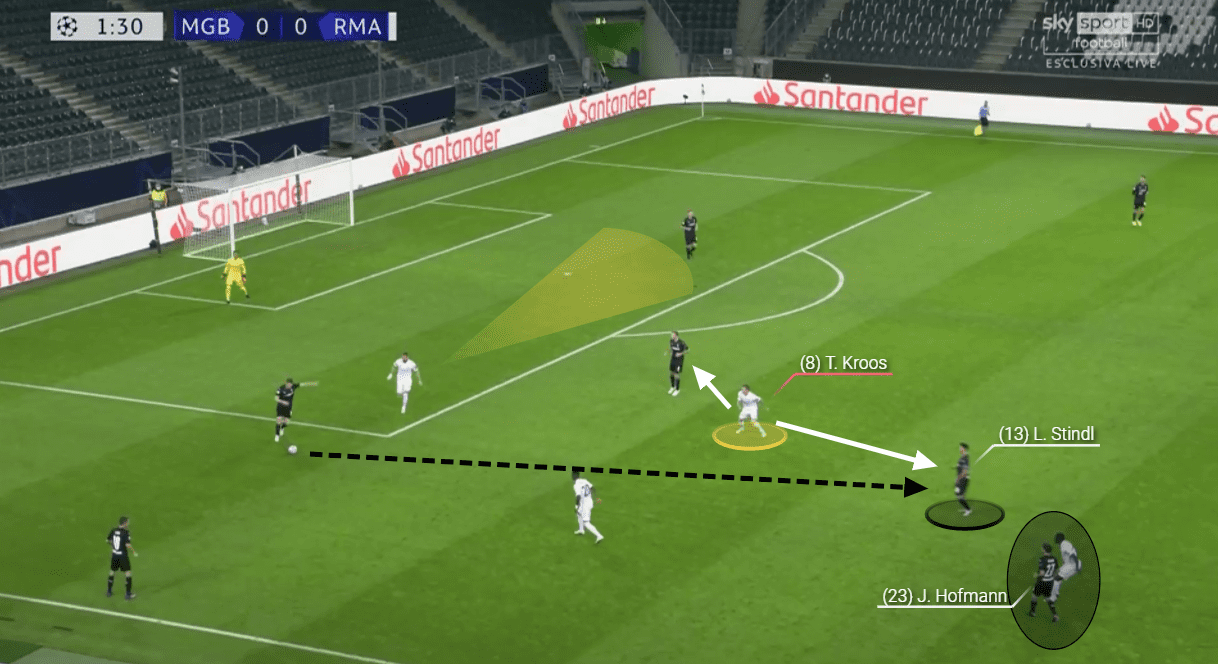
Marco Rose’s tactics was spot on in trying to break through the Real Madrid press. However, the centre-backs’ passing ability were not top notch on the night, especially Ginter’s. Hofmann and Stindl dropped deep to open up passing lanes. Hofmann was marked closely by the left-back but Stindl’s intelligent movement often created a numerical superiority over a Real Madrid player (Kroos, here). However, Ginter did not trust his ball-playing ability and opted for a long ball which resulted in a Die Fohlen turnover.
The other method in which Real Madrid pressed was Valverde man-marking a midfielder and Benzema putting a cover shadow on the other midfielder.
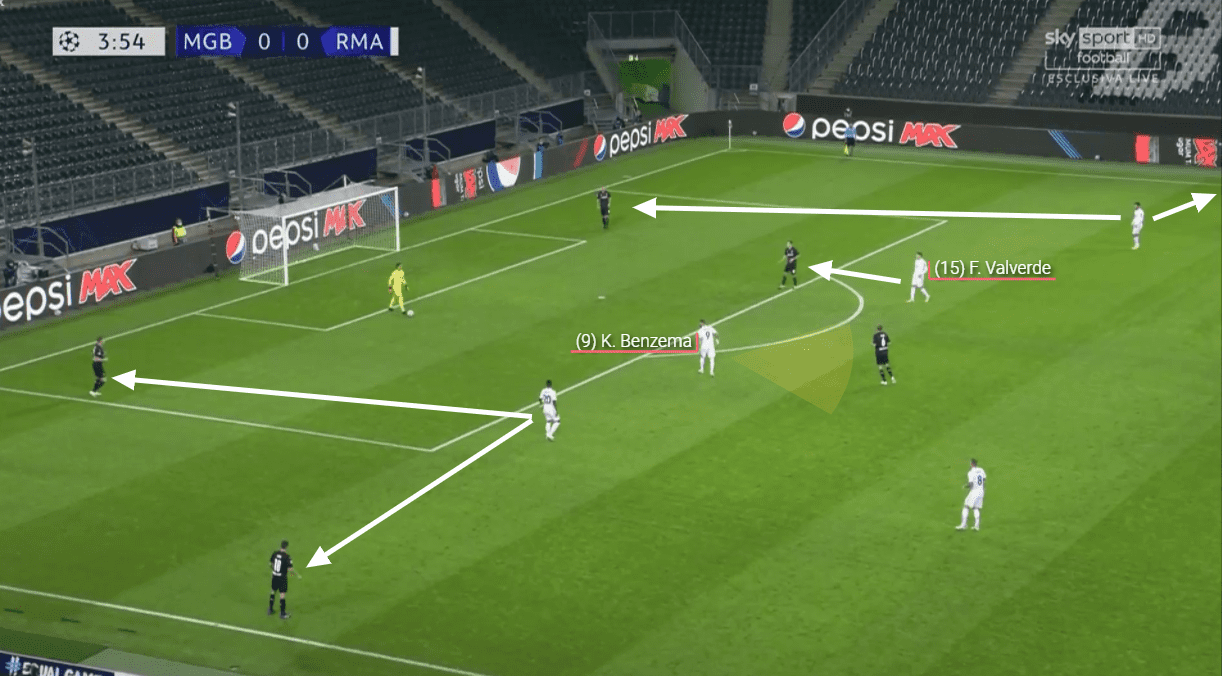
Vinicius Júnior and Marco Asensio sat in between the home team’s respective centre-backs and full-backs with the responsibility of pressing the centre-backs out to in, putting a cover shadow on the full-backs. Kroos positioned himself closer to the M’gladbach right-back, in case the goalkeeper finds a passing lane to the Die Fohlen right-back.
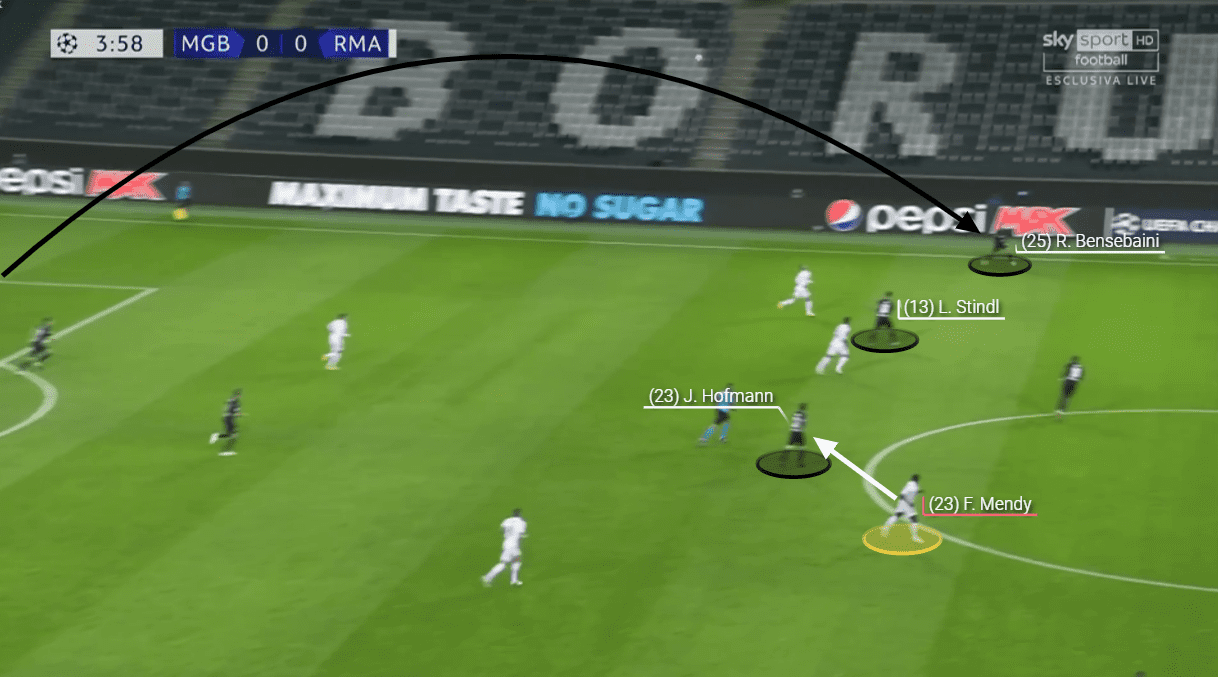
However, there was no one to cover for Asensio as Stindl again tried to create a numerical superiority on the left half keeping Casemiro busy which prompted Sommer to go long wide on the left flank. Out of 13 long balls attempted by Sommer, ten were to the left flank towards the direction of Thuram (LW) or Bensebaini (LB). Another thing to be noticed here is that even when Hofmann positioned himself in the central channel, Ferland Mendy stuck to him.
Real Madrid when not man-marking M’gladbach, pressed the home team in a similar type of press but with different variations. This was because the home team build-up with different structures of their own. The main objective of Real Madrid was to cut off the central passing lanes.
In the image below, Neuhaus vacated the central channel and moved towards the left flank. Hofmann instead dropped very deep acting as the midfielder. Benzema did well to cover shadow the dropping Hofmann. Valverde pressed Elvedi (LCB) and Kroos closely marked Kramer…
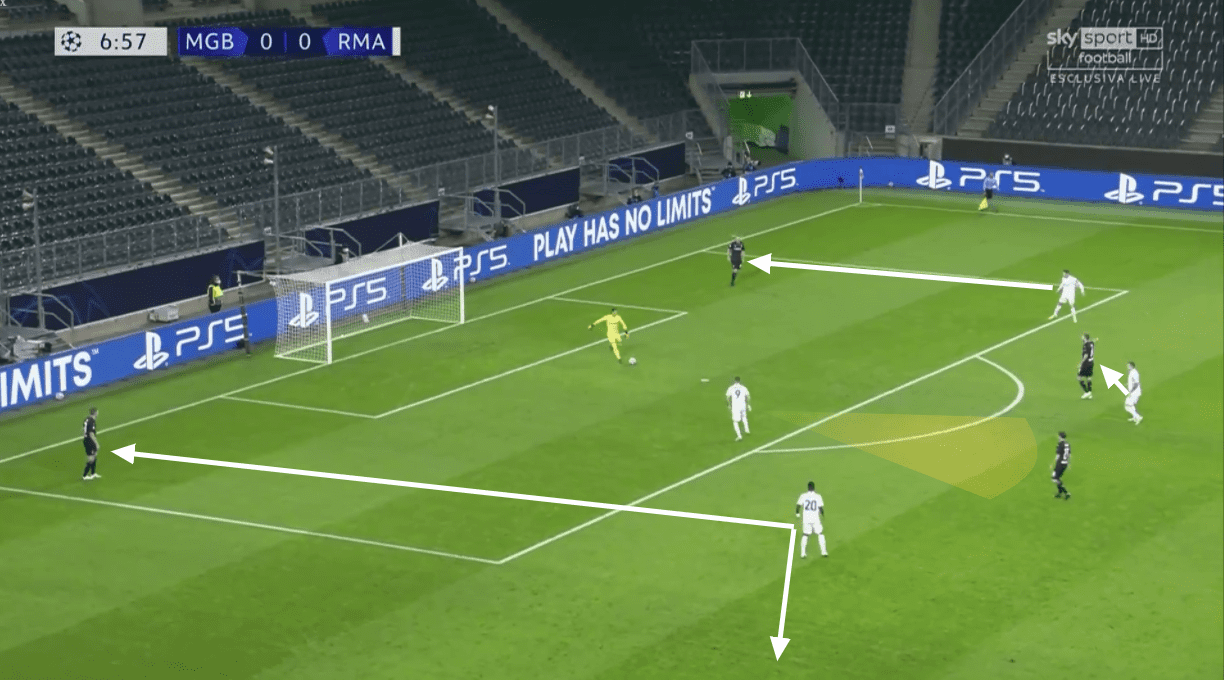
… Asensio had the responsibility of closely marking Bensebaini (LB) to stop the long ball to him and Vinícius had the same job of pressing Ginter (RCB) out to in, putting cover shadow on Lainer (RB).
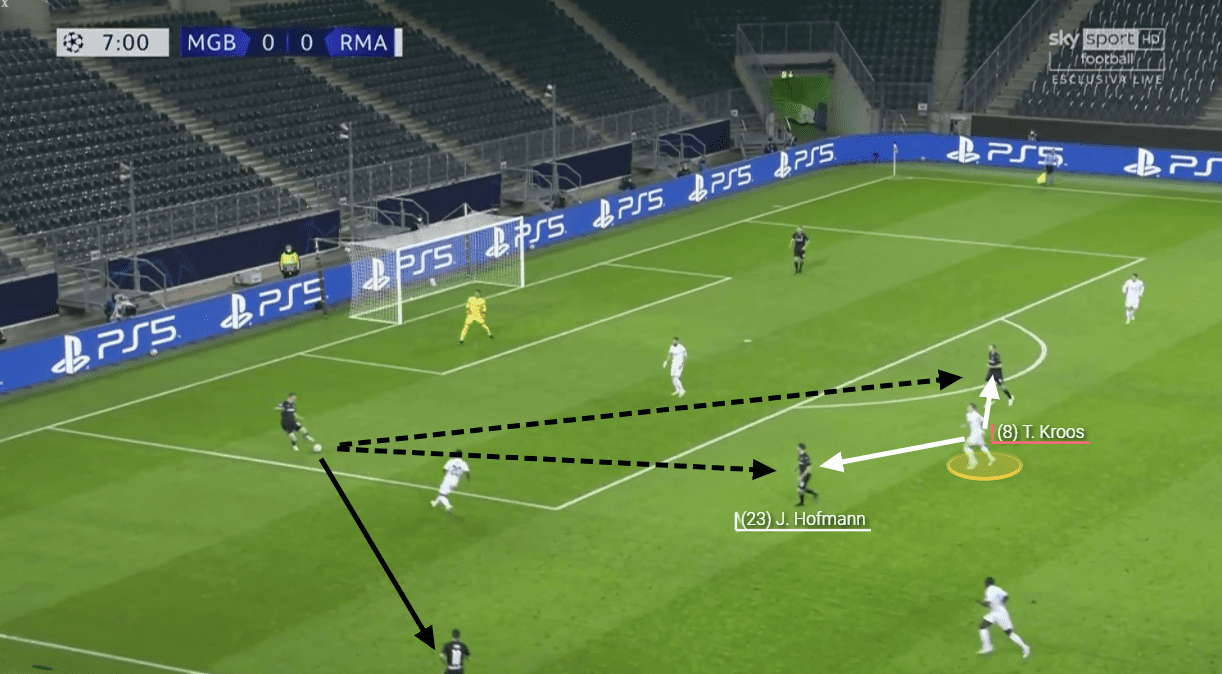
However, Vinícius was poor in pressing throughout the game. The straight body orientation of the Brazilian winger neither puts a cover shadow on Lainer (RB) nor could stop the passing lane to Kramer. Ginter, again, did not opt for a central passing option, which could have been risky.
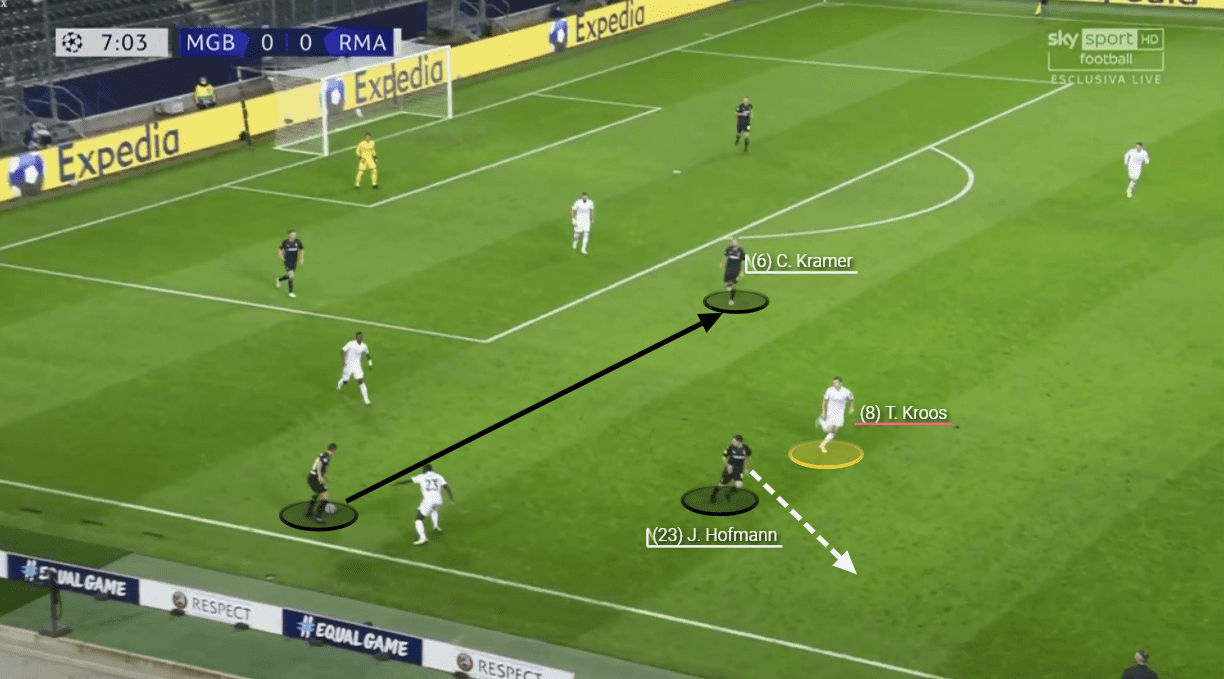
With Benzema putting a cover shadow on Hofmann from the front, the winger creates a numerical superiority on Kroos along with Kramer. Hofmann moving wider drags out Kroos along with him and Lainer could find an easy passing option in the form of Kramer. However poor control by Neuhaus from Kramer’s pass broke the flow of the build-up.
The home team tried various methods to bypass Real Madrid’s press when not man-marked and the tactics looked to be well thought of, however, the poor execution by the players led the team down when building out from the back.
Real Madrid opted for a more man-oriented approach as the game went by as can be seen in the image below.
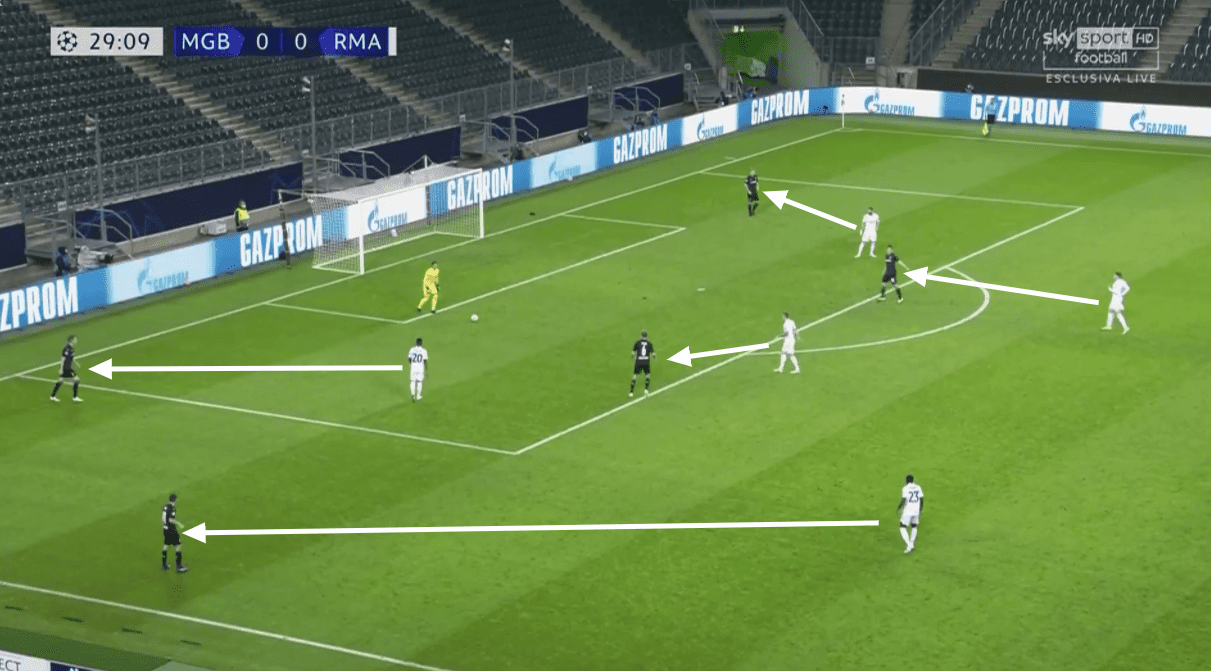
To break away from the man-oriented press, M’gladbach opted for long balls to Thuram as there was a clear mismatch of the aerial ability of the Frenchman with Vázquez and the other method was pass and move.
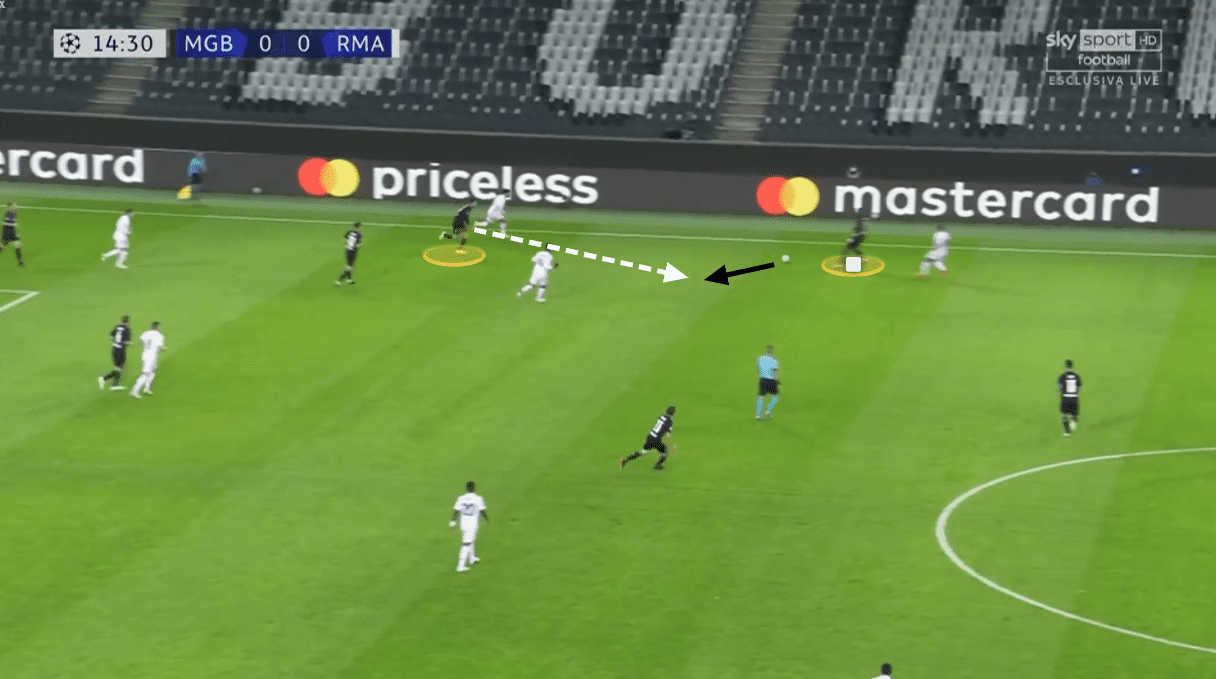
Here, Bensebaini passed the ball to Thuram and carried on with his run. Thuram seeing his teammate’s run laid the ball off to him. This sequence could have put Real Madrid in danger if not for Stindl’s poor final ball.
Creating numerical and qualitative superiority
We have discussed briefly how Borussia Mönchengladbach tried to bypass Real Madrid’s press. One of the key elements was creating a numerical superiority over a Real Madrid midfielder. This was seen in their own half as well as the opposition half.
We have discussed briefly, in the previous section, how Die Fohlen created numerical superiority in their own half. In this section, we will discuss how the home team created the same in the opposition half.
In the opposition half too, the M’Gladbach midfielders were tracked by Kroos and Valverde, and Asensio and Vinícius had the responsibility of keeping track of the Die Fohlen full-backs.
To take advantage of this man-marking, Neuhaus (LCM) often positioned himself wide on the left-flank, acting as the pseudo left-back and Bensebaini was pushed higher.
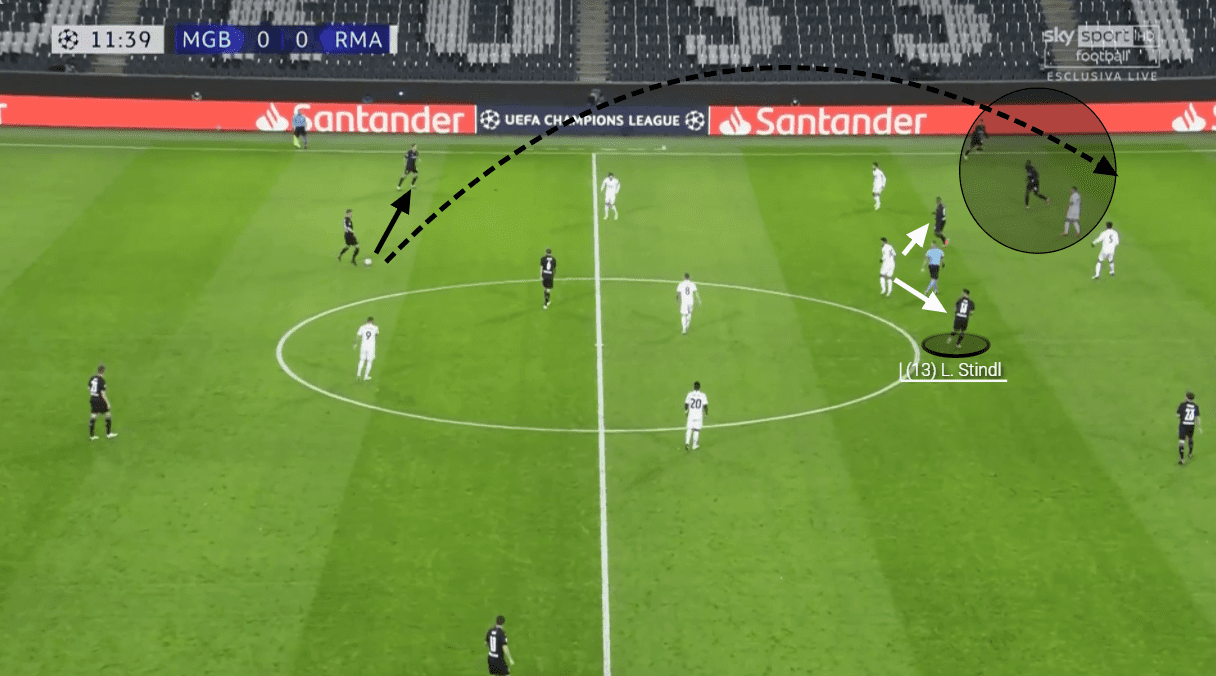
Valverde and Kroos stuck to their job. However, Asensio could not keep track of Bensebaini, thus Bensebaini and Thuram created an overload on Vázquez. However, Elvedi could not spot the intended run of Bensebaini and opted for a safe pass to Neuhaus. If you notice, Plea also drops to the half space to create an overload on Casemiro with Stindl.
Marco Rose utilised the intelligent Stindl extensively to create numerical superiority.
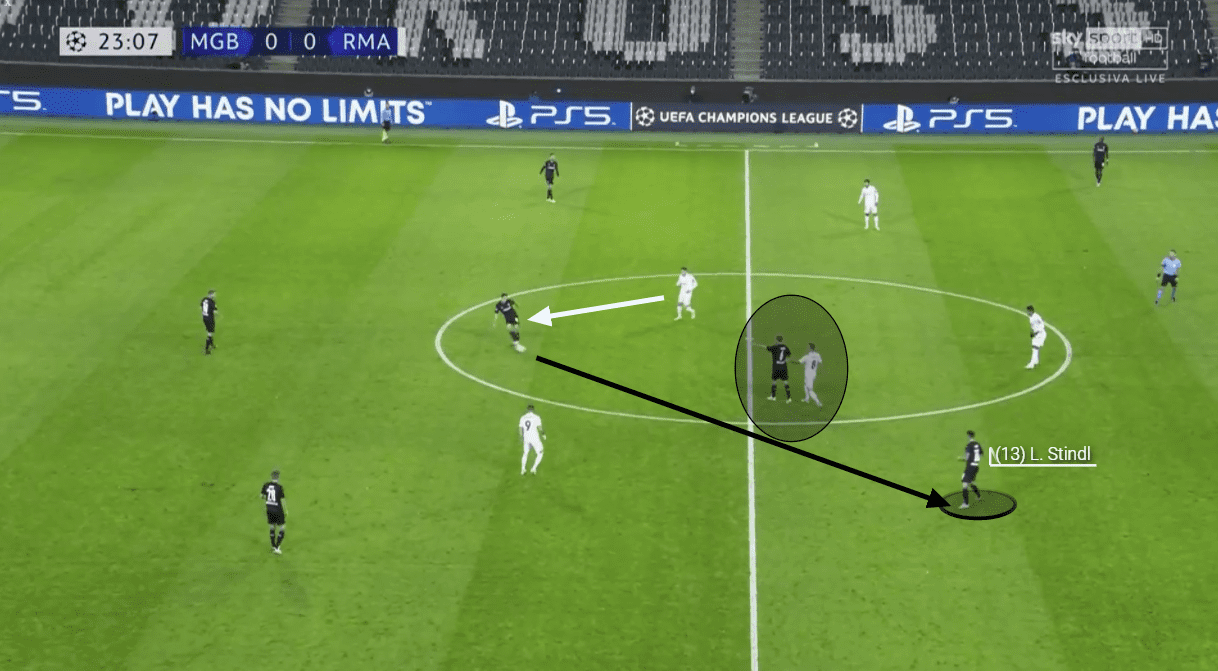
Here, again, Valverde and Kroos mark Neuhaus and Kramer respectively. Casemiro keeps the defensive shape. Stindl observing the space on the left of Kroos decides to drop to the space and creates a passing lane for Neuhaus.
Stindl along with his teammates created numerical superiority over Real Madrid players, especially the midfielders. Along with the numerical superiority on the midfielders, Die Fohlen also tried to target the right flank of Real Madrid owing to Asensio’s poor tracking ability, as shown in the first image of this section.
Around the 40 minutes mark, the home team again created a similar situation with Thuram dropping deep and dragging out Vázquez leaving Bensebaini one on one with Asensio, thus creating a qualitative as well as positional superiority.
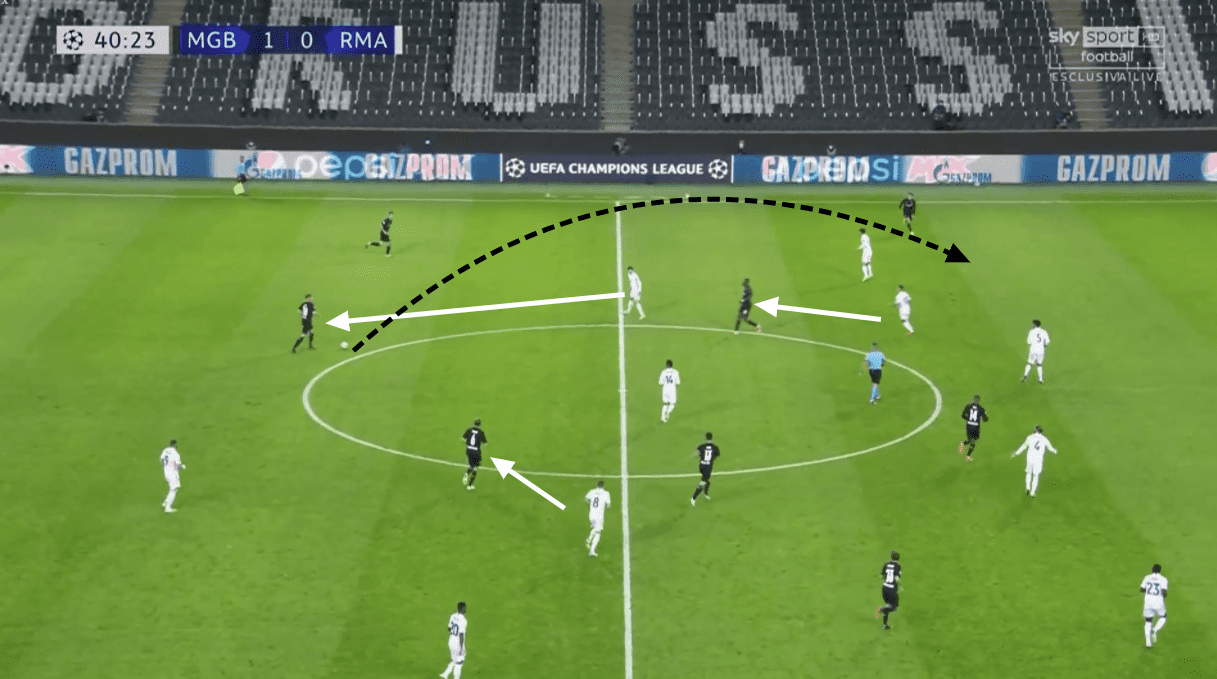
Bensebaini timed his run perfectly only to be unseen by Elvedi (LCB).
Die Fohlen could have troubled Real Madrid far more than they did on that night if not for the poor passing ability shown by the centre-backs.
Borussia Mönchengladbach’s intelligent press
Borussia Mönchengladbach swayed away from their regular high pressing and decided to press in a midblock, but not too aggressively, in order to create pressing traps mostly on the flanks. The difference in their pressing could be partially understood by Die Fohlen’s 22.43 PPDA (Passes Allowed per Defensive Actions) against Real Madrid compared to their average being 11.5 for this season.
Die Fohlen pressed the Los Blancos in a 4-4-2 space oriented man-marking, with the entire unit moving with respect to the ball. Space oriented man-marking is a mixture of zonal marking and man-marking. Each player has a space to cover and marks the opposition player who gets into his space.
Stindl joined Plea in the first line of press and protected the passing lanes to Kroos and Casemiro. It forced the Real Madrid build-up towards the flanks.
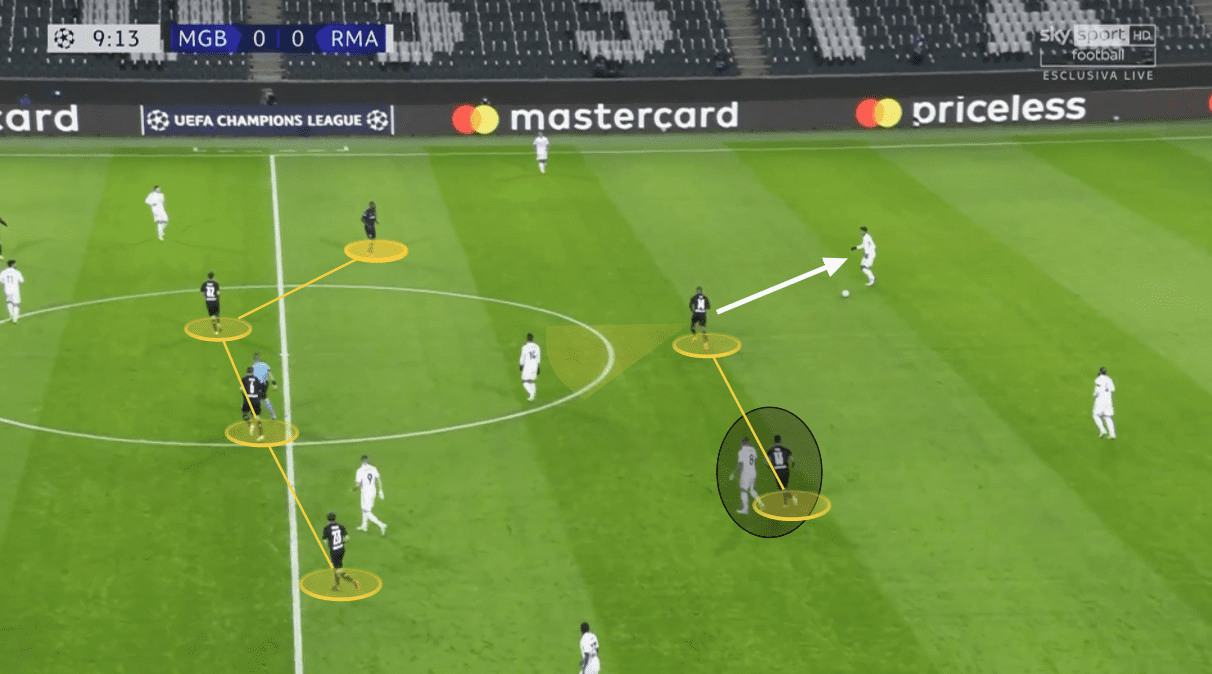
When the ball was passed to Vázquez on the right flank, Thuram would press the Spaniard in to out thus preventing the pass to an advanced played in the central channel. Stindl would also move left to mark the ball-near midfielder and Bensebaini would mark Asensio closely.
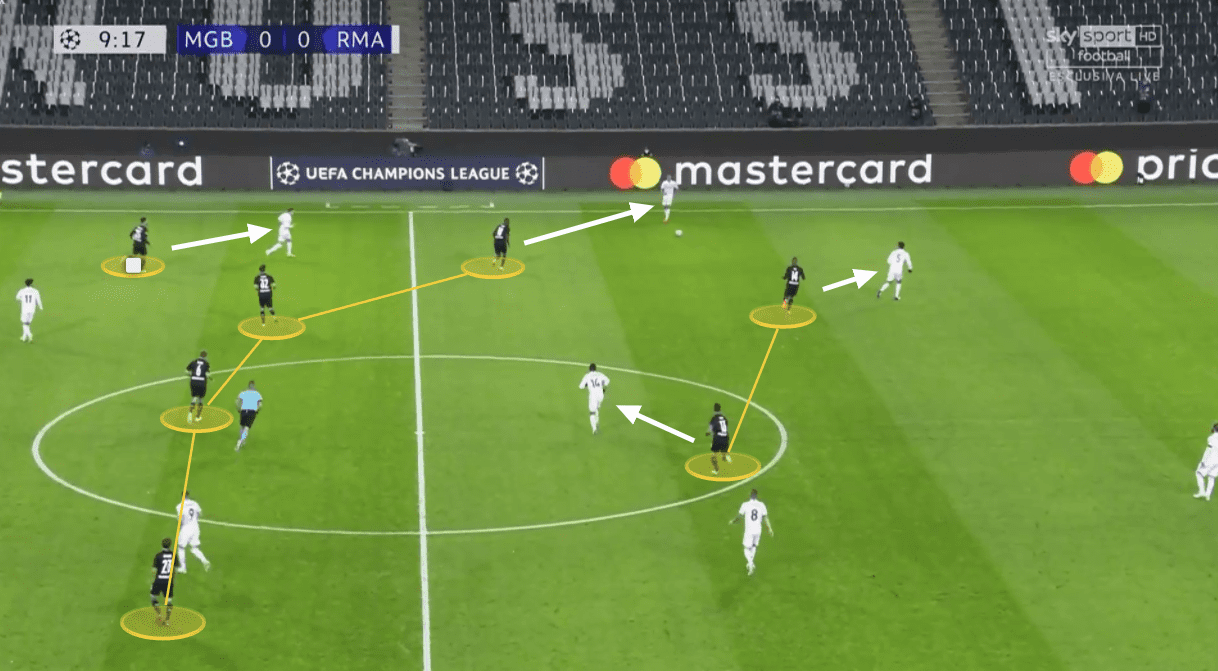
It would leave the Los Blancos right-back with no option but to play it back to the Varane. The same thing happened in the other flank too.
When the centre-backs are wide and take a lot of time on the ball. The wingers have the license to press the centre-back out to in, putting a cover shadow on the left-back.
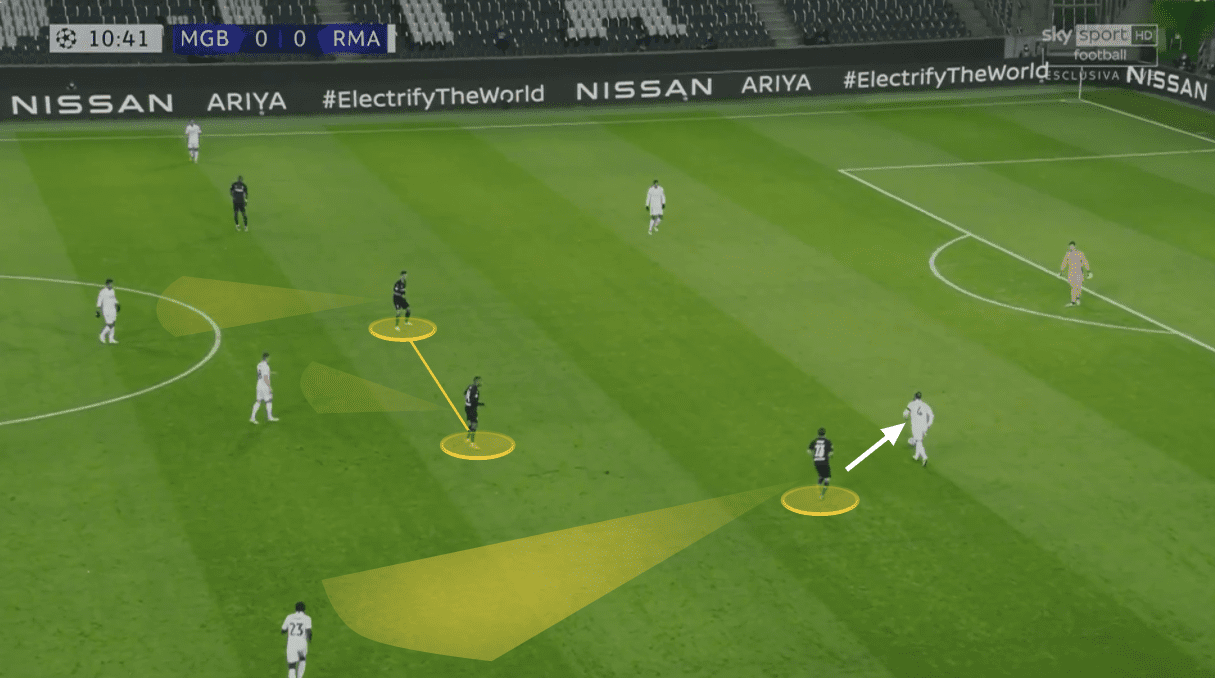
To get away from the press, Kroos was advised to act as the pseudo left-back pushing Mendy higher on the flanks or to the half space as Real Madrid do in most of their games. When Kroos acted as the pseudo left-back, Hofmann would press Kroos with a body orientation depending upon Mendy’s position.
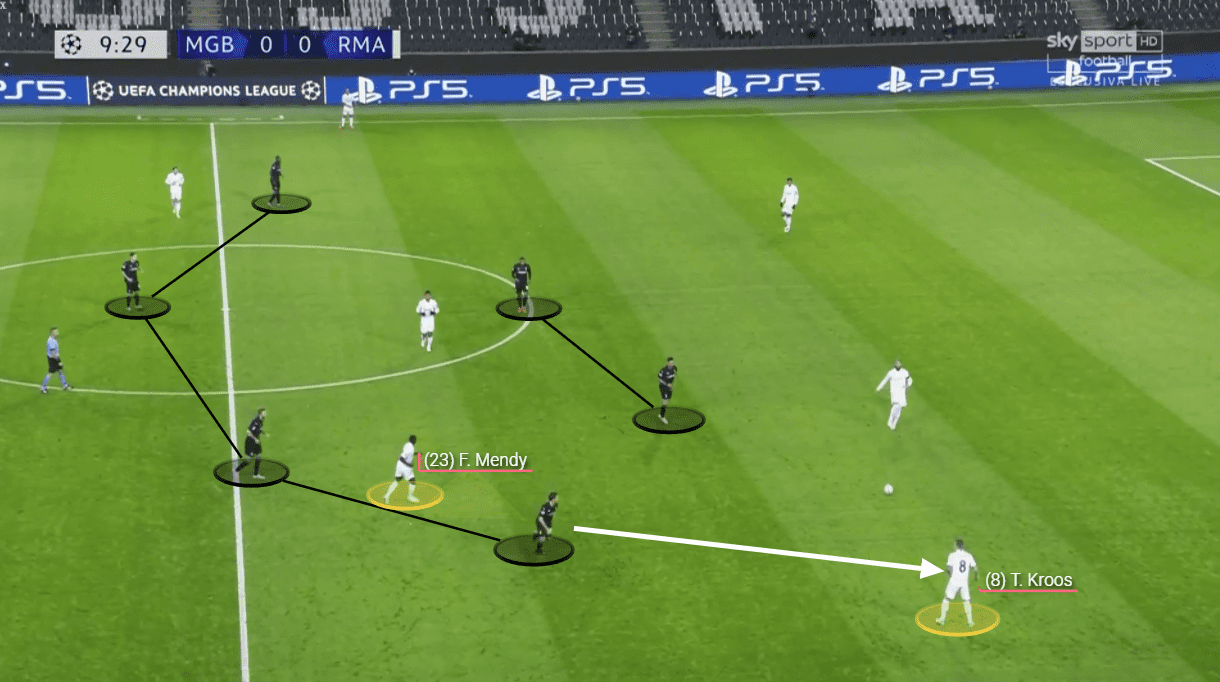
If Mendy occupies an inverted position, the right-winger presses Kroos in to out cutting a passing lane to the inverted Mendy.
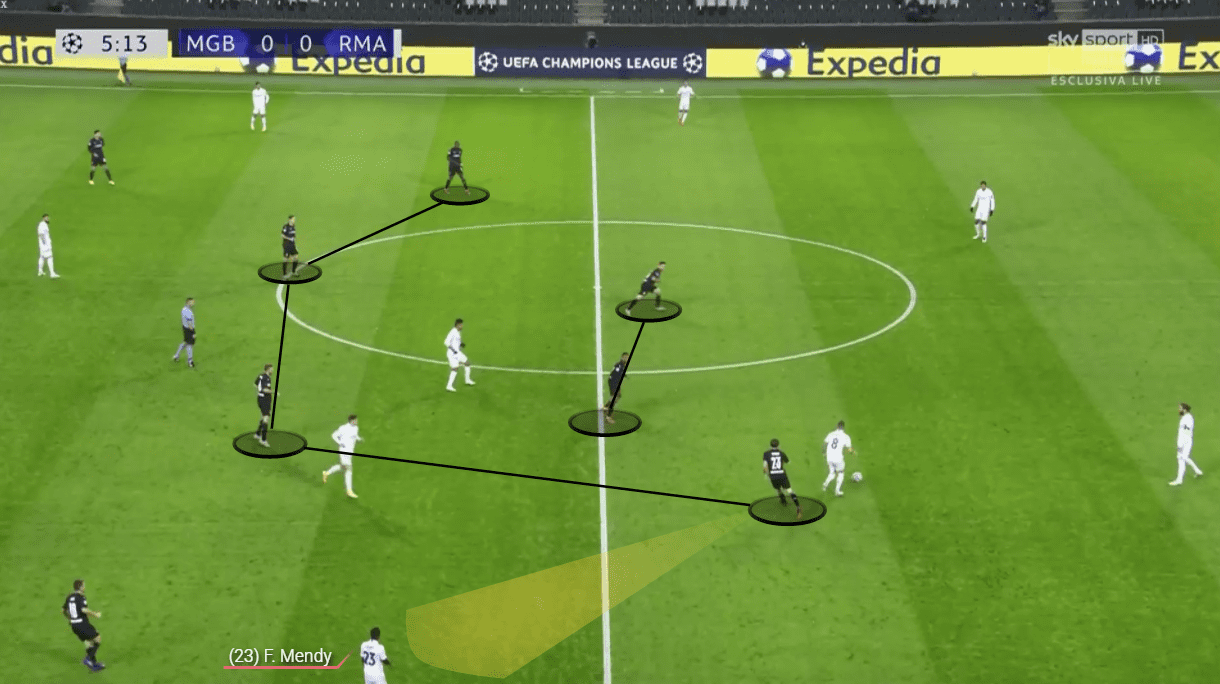
If Mendy occupies a position on the flanks, the right-winger presses Kroos out to in, now, cutting the passing lane to Mendy who occupies a position on the flanks.
Real Madrid’s build-up and Die Fohlen’s pressing traps
Real Madrid primarily used Kroos as the pseudo left-back as discussed in the previous section. However, the main idea was to rotate the full-backs, wingers, and Kroos to open up passing lanes to build-up from the back.
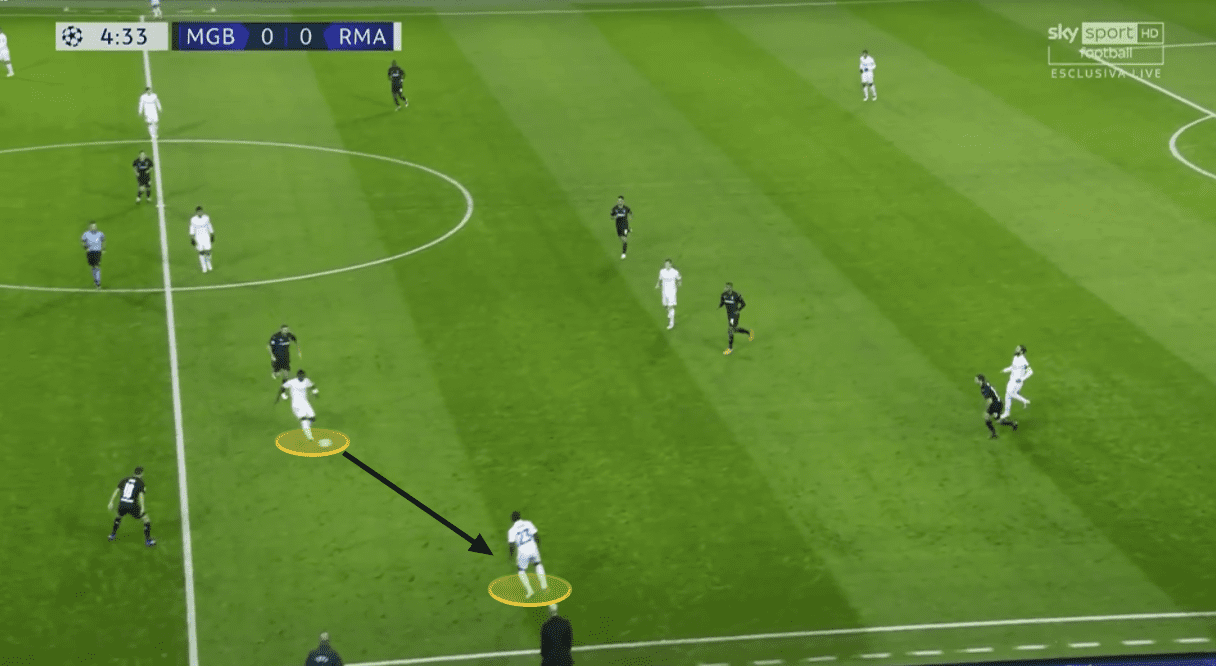
When Real Madrid kept their original shape, Vinícius would drop deep to open up a passing lane. However, when he dropped deep, he would position himself into the space of the M’gladbach RCM and not on his blindside, which would make the RCM’s work easy to track the winger. The Brazilian winger would have no other option but to pass the ball to Mendy.
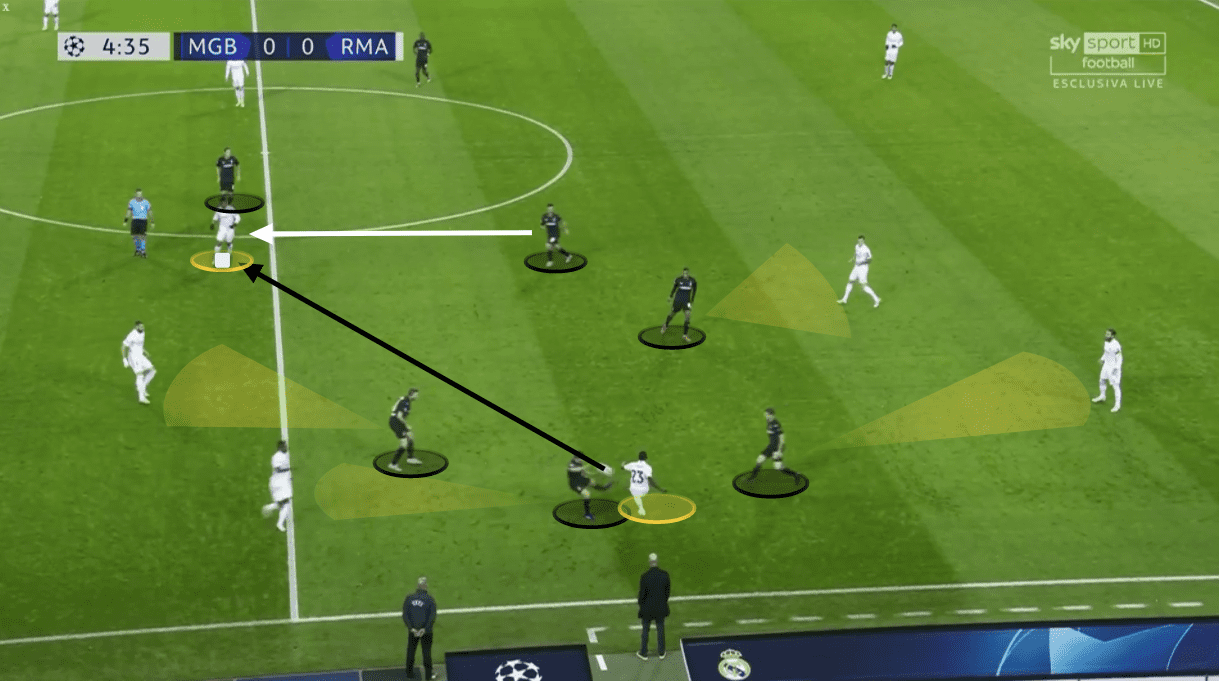
When that happens it would result in a pressing trap. Lainer would move up to press Mendy with Hofmann moving up to press Ramos out to in. In the process, he would put a cover shadow on Ramos. Plea would be marking Kroos and the other ball near players would also be marked. However, in this case, Casemiro makes an intelligent movement thus taking him away from his marker, Stindl, and also in front of the midfielder, Neuhaus. Mendy used the Brazilian midfielder and progressed the ball forward.
Again, in the image below, you could see Real Madrid taking the help of Casemiro in circulating the ball, with Stindl behind the Brazilian.
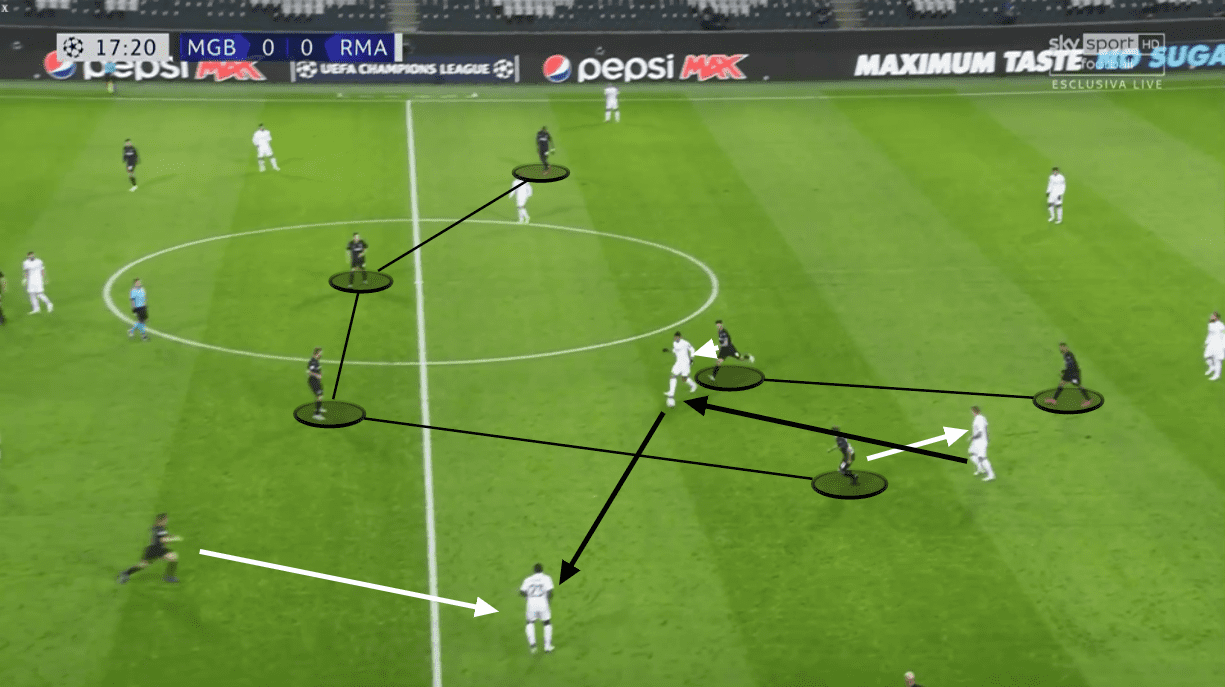
However, in this case, Los Blancos fell in the M’Gladbach pressing trap. Once Casemiro passed the ball to the flank, Die Fohlen’s pressing trap was initiated.
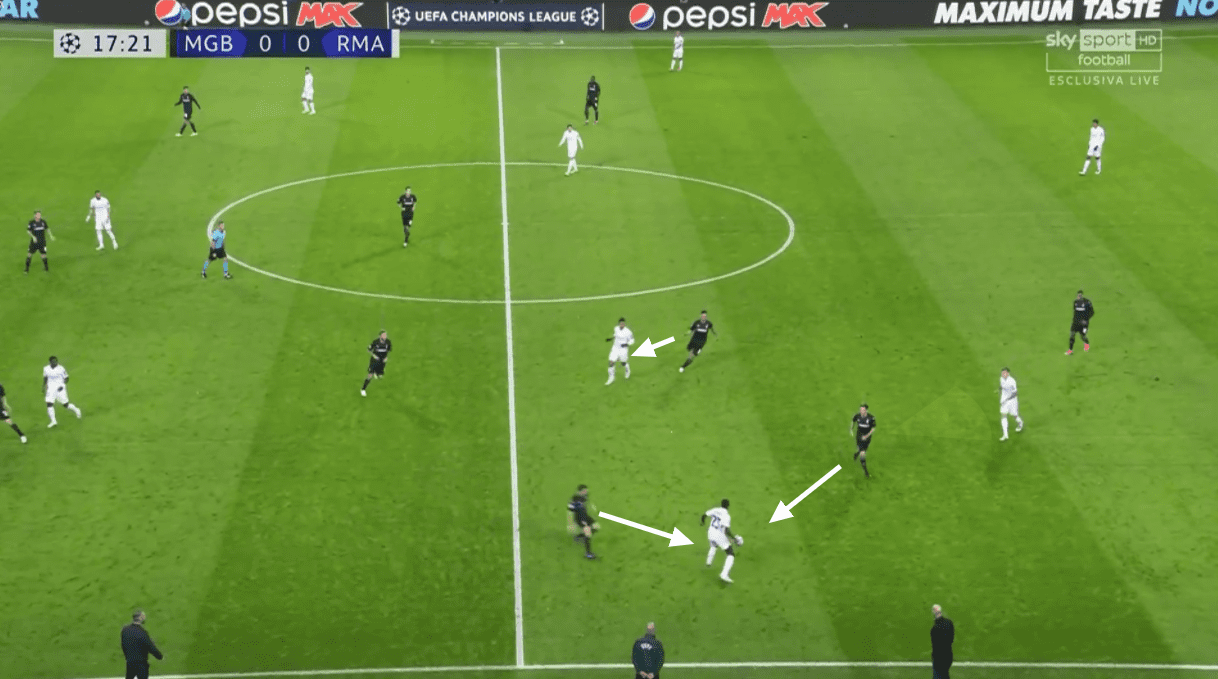
Hofmann now puts a cover shadow on Kroos and Casemiro was marked well by Stindl. Mendy was marked by Lainer (RB) from behind which leaves him with no short passing option. Mendy does well to hold onto the ball and earn a foul for his team.
Space oriented man-marking can be best exposed by creating numerical superiority on a space and thus the player. Since each player covers a certain space, it becomes easier for the opposition team to overload that space. However, Los Blancos could not expose Die Fohlen’s system. One reason was that the German team were very compact and left very little space in between the lines and the other reason was that the Real Madrid players’ movement were too limited. Real Madrid tried to build-up from both the flanks. The away team succeeded a little from the right flank but Vinícius’ poor movement on the left flank coupled with Kroos’ off night did not help Los Blancos’ cause on the left.
Even when Vinícius positioned himself on the blindside of M’Gladbach’s second line of press, he would be closer to the last defensive line.
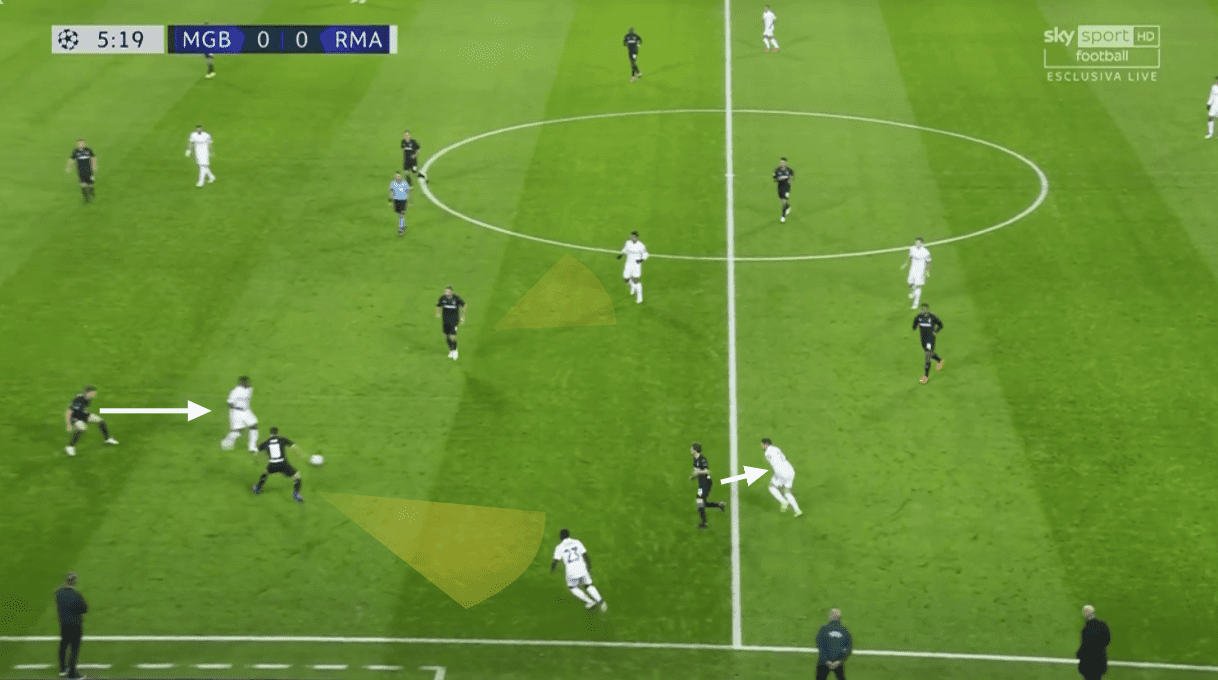
Instead of taking a chance by taking on the defender, he would opt to pass the ball back to his teammates. However, that option would be cut off as Lainer (RB) would also be looking to press the winger by cutting off the passing lanes to Mendy. In the process, Los Blancos would end up losing the ball.
Even when the full-backs and wingers would rotate with the full-backs inverting and leaving the space for the dropping wingers to exploit, Die Fohlen players and Rose’s tactics were up to the task and they would prevent Real Madrid from progressing the ball further.
Die Fohlen are the architect of their own downfall
Die Fohlen went on a passive mode after Eden Hazard and Luka Modrić were subbed on. It led to the home team’s downfall along with Hazard’s positioning and Modrić’s passing.
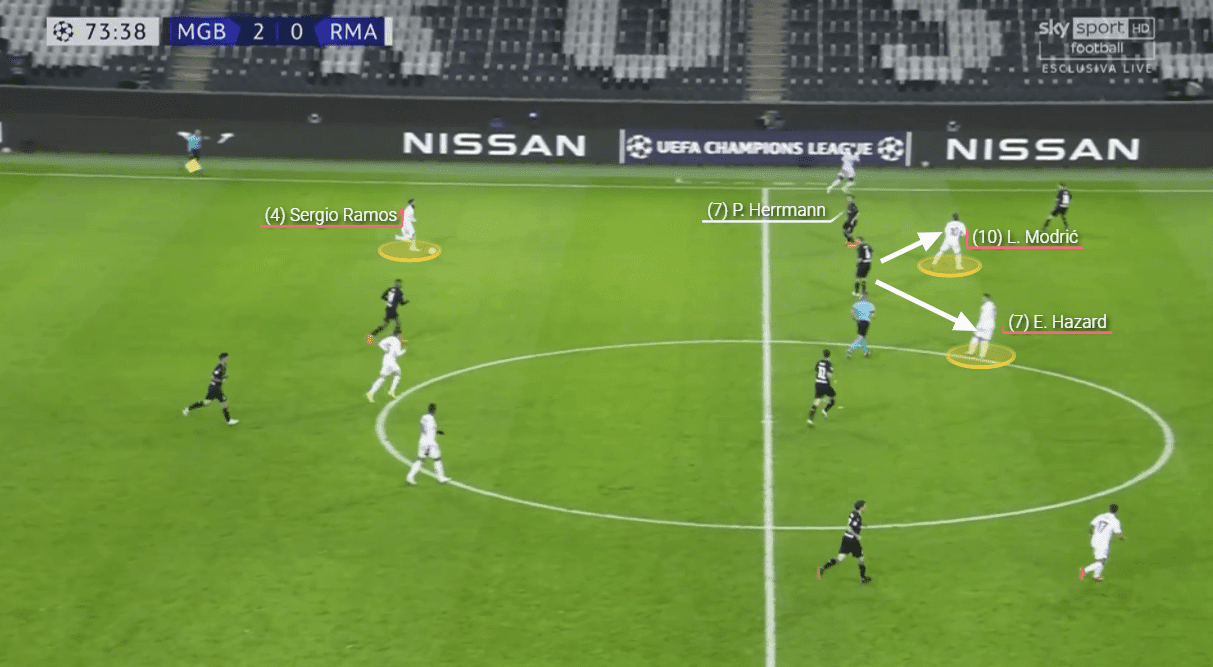
As you can see here, the M’Gladbach right-winger (Patrick Hermann subbed on for Hofmann) instead of pressing Ramos, backtracks to keep a more defensive shape. It gave Ramos too much time on the ball and also helped Modrić and Hazard to position themselves in between the lines and create a numerical superiority over Kramer which was non-existent before.
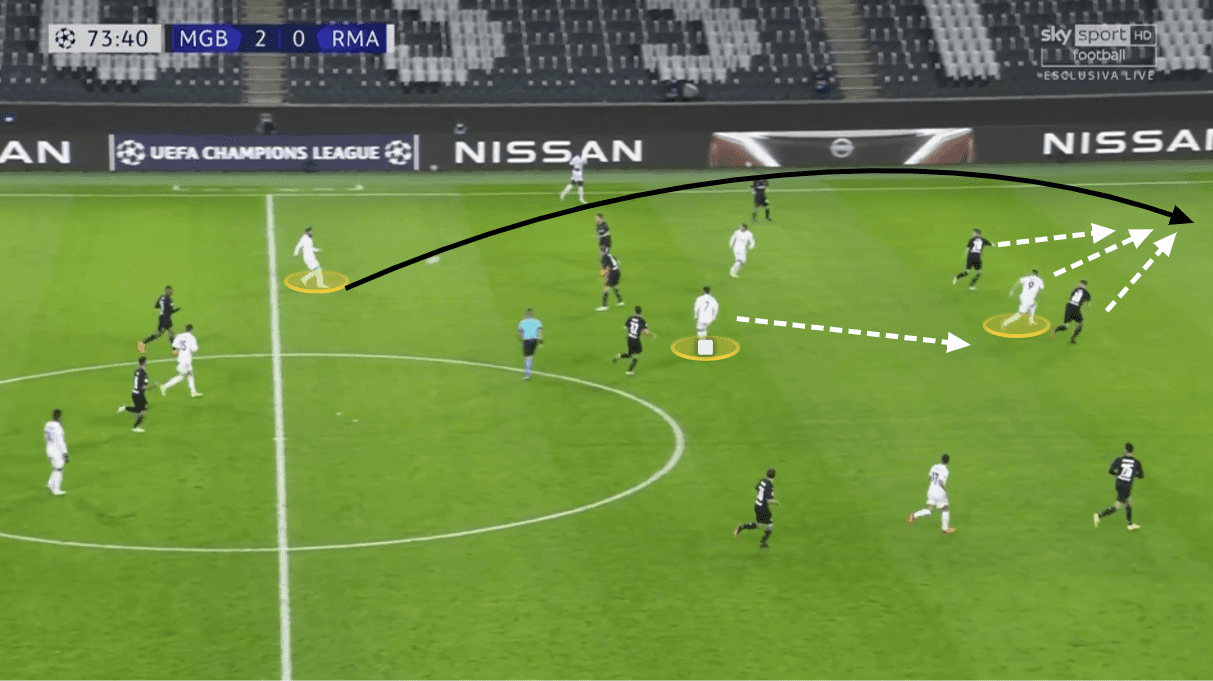
With Ramos having too much time on the ball, he could easily pick out a perfect pass. He plays a lob through to Benzema which engages both the centre-backs.
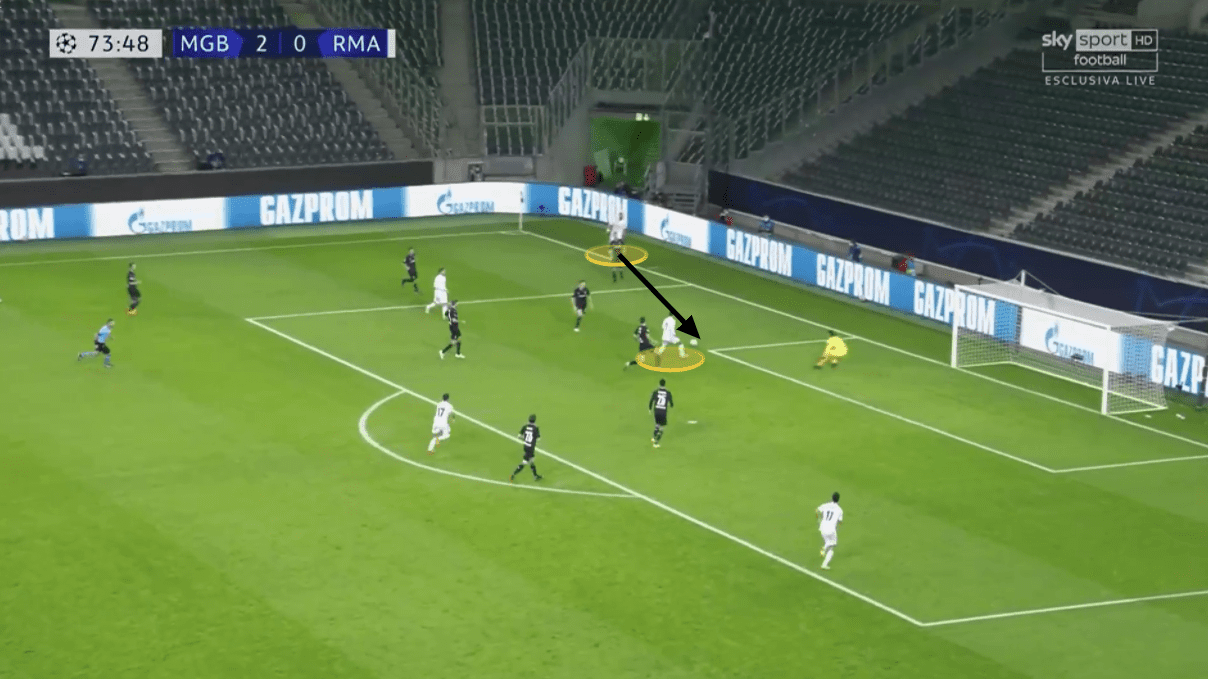
With Hazard on the blindside of the second line, he has an advantage over the midfielders. He gets into the box with Neuhaus grasping to get back in time. Hazard’s shot was off target but it started the proceedings for a Real Madrid comeback.
Even in the final third the trio of Mendy, Hazard, and Modrić rotated intelligently to free up space for one or the other.
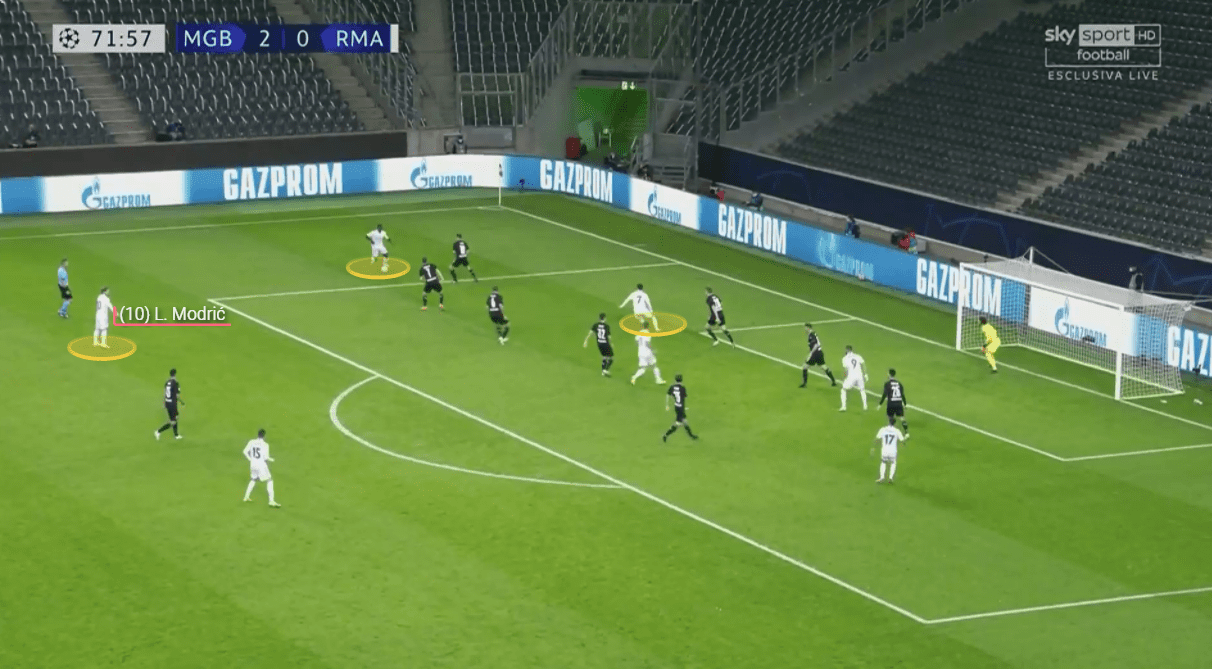
Here, the trio rotated and found the Croatian midfielder on the edge of the box with a lot of time and space.
Marco Rose was also to blame in the dying minutes. With Ramos pushed forward into the 18-yard-box along with other Real Madrid players, he did not tweak his system. In the process, Real Madrid had more number of bodies in the opposition box.
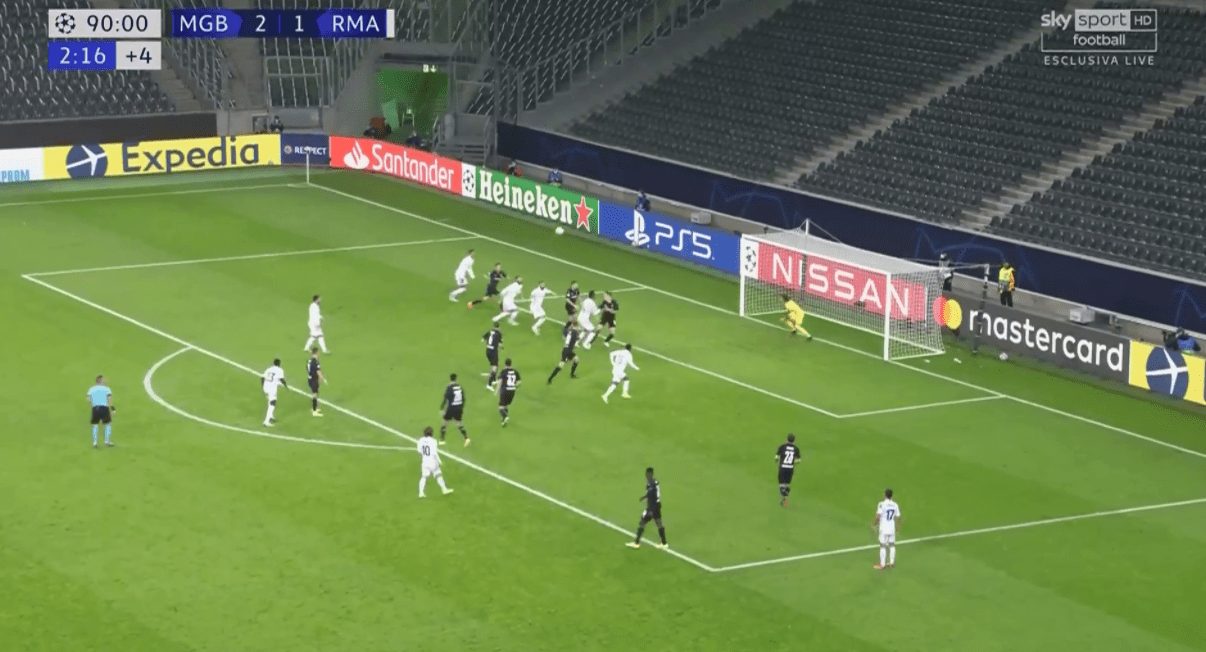
Here, you can see, four Real Madrid players attacking M’gladbach’s three players in the last line of defence and equalising from this segment of play.
Conclusion
Borussia Mönchengladbach had a clear gameplan. Die Fohlen pressed Real Madrid with a midblock and created pressing traps on the flanks. When they won back the ball, the home team tried to transition quickly. Die Fohlen tried to attack Real Madrid’s right flank owing to Asensio’s poor tracking ability as well as Thuram’s brilliant off the ball movement. The German team could also have troubled Los Blancos through their build-up, however, the inefficiency of M’gladbach centre-backs’ ball playing ability on the night let them down.
Real Madrid had patches of good stints in the build-up but were mostly trapped by the German team with their intelligent pressing. Hazard and Modrić completely changed the dynamics of the game after being subbed on. Die Fohlen’s passive approach amalgamated with the duo’s brilliant ability on and off the ball created havoc in the opposition defence.
Marco Rose would not be a happy man after drawing the game from the verge of earning a brilliant victory. The win would also have taken them to four points from two games, leaving Real Madrid with zero points. Now, the equation gets much more difficult for the German team to qualify for the next round.






Comments